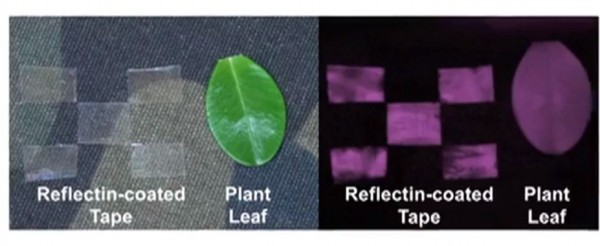Scientists Draw Inspiration from Squid for New Camouflage Combat Technology Called 'Invisibility Stickers'
| Dino Lirios | | Apr 13, 2015 05:16 AM EDT |
Reflectin tape under normal light (left) and under ultraviolet light where it is indistinguishable from a leaf.
Scientists look to improve the camouflaging abilities of soldiers by developing combat technology derived from one of the world's oldest organisms, the squid.
For millions of years, squids have swum in the waters of the Earth. They belong to one of the oldest organism groups, the cephalopods, which include octopus and cuttlefish.
Like Us on Facebook
Scientists say the reason why squids still survive and thrive is because they have mastered the art of camouflage. Leaping off from this point, scientists have begun to develop technology that will help soldiers avoid any kind of infrared detection.
Researchers from the University of California used squid proteins to develop "invisibility stickers" that can be easily used by soldiers on the ground.
Alon Gorodetsky, assistant professor of chemical engineering and material sciences, say troops normally wear green and brown camouflage patterns to blend into foliage. They are, however, still vulnerable to infrared detection.
Focusing their attention on squid cells known as iridocytes, Gorodetsky and his team used a light-reflecting protein -- reflectin -- and synthesize it onto a packing tape-like surface to create the stickers.
Using any chemical or mechanical stimulus, the reflectin-coated stickers can be changed into any color needed.
Gorodetsky says the applications of the sticker are flexible. One example he gave is if a person were to put the stickers all over, the soldier would then look a certain way under optical visualization and a different way under infrared visualization.
This combat technology isn't yet ready to be used in combat areas as researchers are still working on developing an adaptive camouflage system that allows a group of stickers to work in sync, in turn responding to varying infrared wavelengths.
The research work was just presented at the 2015 American Chemical Society national meeting.
When speaking about the inspiration for it, Gorodetsky said inspiration could be drawn from natural systems that have been perfected over millions of years.
Adapting these systems for human use will take some time, however.
TagsSquid, reflectin, Combat technology, Invisibility Stickers
©2015 Chinatopix All rights reserved. Do not reproduce without permission
EDITOR'S PICKS
-

Did the Trump administration just announce plans for a trade war with ‘hostile’ China and Russia?
-

US Senate passes Taiwan travel bill slammed by China
-

As Yan Sihong’s family grieves, here are other Chinese students who went missing abroad. Some have never been found
-

Beijing blasts Western critics who ‘smear China’ with the term sharp power
-

China Envoy Seeks to Defuse Tensions With U.S. as a Trade War Brews
-

Singapore's Deputy PM Provides Bitcoin Vote of Confidence Amid China's Blanket Bans
-

China warns investors over risks in overseas virtual currency trading
-

Chinese government most trustworthy: survey
-

Kashima Antlers On Course For Back-To-Back Titles
MOST POPULAR
LATEST NEWS
Zhou Yongkang: China's Former Security Chief Sentenced to Life in Prison

China's former Chief of the Ministry of Public Security, Zhou Yongkang, has been given a life sentence after he was found guilty of abusing his office, bribery and deliberately ... Full Article
TRENDING STORY

China Pork Prices Expected to Stabilize As The Supplies Recover

Elephone P9000 Smartphone is now on Sale on Amazon India

There's a Big Chance Cliffhangers Won't Still Be Resolved When Grey's Anatomy Season 13 Returns

Supreme Court Ruled on Samsung vs Apple Dispute for Patent Infringement

Microsoft Surface Pro 5 Rumors and Release Date: What is the Latest?












